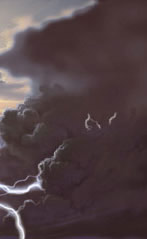
OPOD
What's New
Rays & Shadows
Water Droplets
Rainbows
Ice Halos
Contents
Crystals
Frequent Halos
Infrequent Halos
Multiple Displays
Other Worlds
Mars
Jupiter
Saturn
Observing Halos
HaloSim
High Atmosphere
Links & Resources
Search - Index
123456789012345678
| Jupiter |
|
||||||||
20-30 km deeper there are clouds formed from ammonium hydrosulfide crystals. They are probably darkened and coloured by sulfurous or phosphorus polymers and organic compounds. Not enough is known to predict their halos. 60 km beneath the ammonia cloud layer we find superficially Earthlike clouds of water molecules. Pressures are 5-6 bar and temperatures are similar to those of Earth. Their windblown anvils and cirrus push high into the hydrosulfide layer and their ice crystals could form Earthlike halos. Their lower levels have liquid droplets and rain or drizzle warm corrosive ammonium hydroxide solution down into the depths. In summary, Jupiter's high ammonia cloud layer could form halos from its octahedral, cuboctahedral or even rhombic dodecahedral crystals like those predicted for CO2 clouds on Mars . Much deeper, when the weak sun penetrates through, water-ice cirrus might give glimpses of Earthlike halos. |
||||||||



